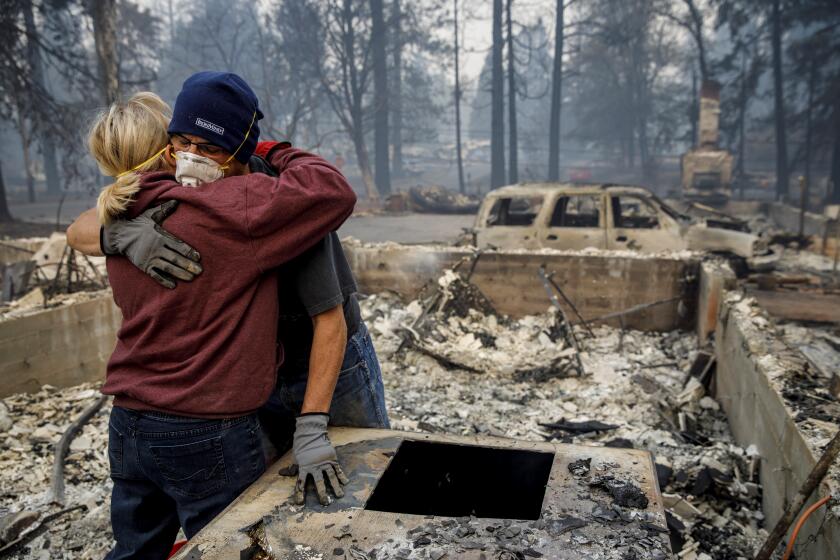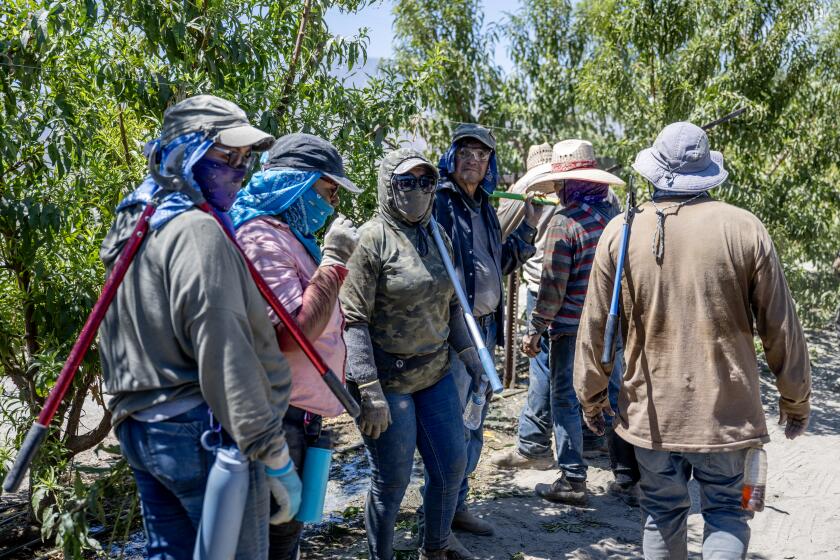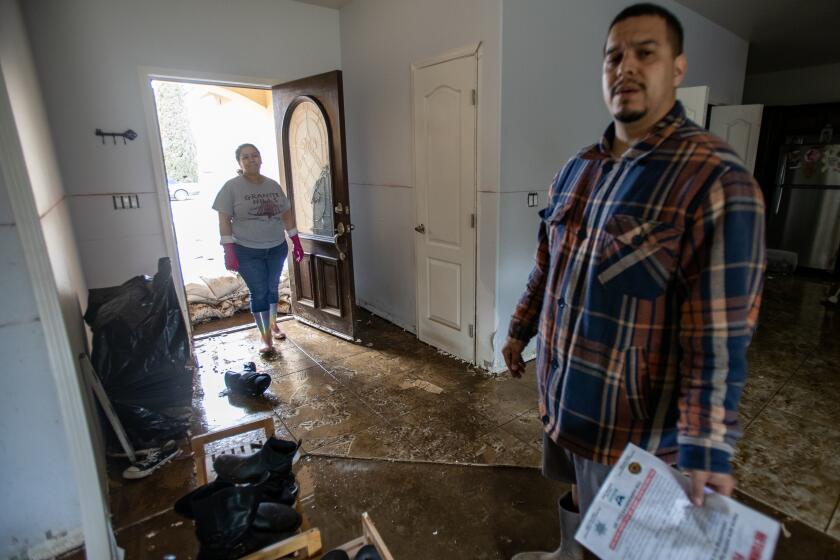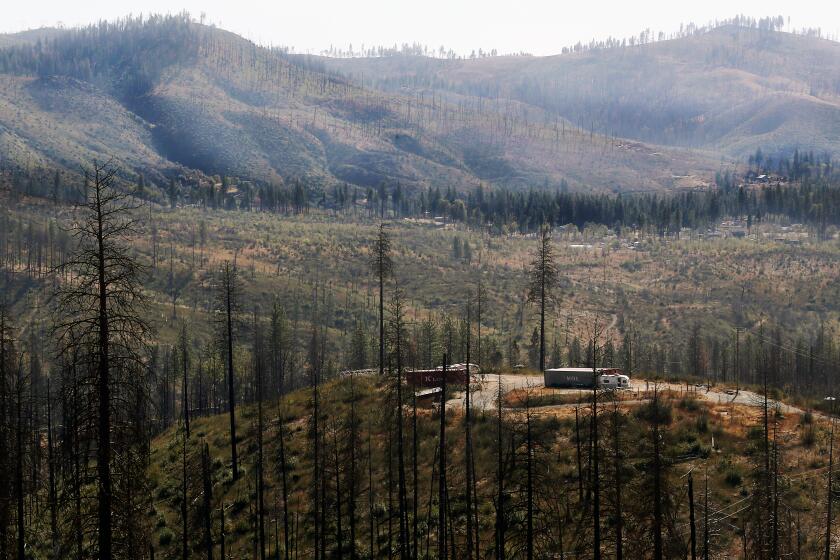
- Share via
The dire effects of human-caused climate change are worsening and they threaten to bring more extreme heat waves, droughts, floods and wildfires unless urgent actions are taken, scientists warned in a major national report.
The Fifth National Climate Change Assessment, released Tuesday by the White House, reveals the high stakes for Americans as the nation confronts global warming. Efforts to adapt to climate change and curb the burning of fossil fuels have expanded since the last assessment was issued in 2018, the report says, but “without deeper cuts in global net greenhouse gas emissions and accelerated adaptation efforts, severe climate risks to the United States will continue to grow.”
In California and the Southwest, increasing temperatures have intensified drought and will lead to a more arid future, while extreme heat will harm crop production and bring widespread economic impacts. However, report authors also wrote that action to prevent additional heating of the planet will bring major benefits by lessening the severity of the changes.
“This report says every 10th of a degree of warming matters. Every bit matters,” said Katharine Hayhoe, chief scientist for the Nature Conservancy and one of the authors. “It clearly shows that per 10th of a degree of avoided warming, we save, we prevent risk, we prevent suffering. And that’s pretty powerful.”
The report addresses the environmental, economic and human-health impacts of a changing planet, and contains contributions from more than 700 experts and scientists. Here are six takeaways:

1. The more the planet warms, the greater the impacts
Rapid warming from greenhouse gas emissions are contributing to large-scale planetary changes, including rising sea levels, melting ice, warming oceans and shifts in the timing of seasonal events, the report says. Emissions are driven by the burning of fossil fuels, as well as deforestation, agricultural practices, manufacturing and other sources.
For humanity, the changes are unprecedented. Atmospheric greenhouse gas levels are the highest they’ve been in at least 800,000 years. Most of those emissions have occurred since 1970.
The climate change signal is “even clearer today than it was five years ago,” Hayhoe said. In the U.S., people across all regions are experiencing hotter temperatures and longer-lasting heat waves, with nighttime and winter temperatures warming the fastest.
Aggressive and impactful reporting on climate change, the environment, health and science.
Hayhoe said the report “explains how climate change is affecting us now, how it’s affecting us here in the places where we live, and how it’s affecting every sector of our society, as well as the natural environment that surrounds us.
“It shows us that if we live in the U.S., the risks matter, and they’re affecting us already today,” she said.
The risks from extreme events are growing, with more billion-dollar disasters occurring each year. In the 1980s, the U.S. experienced an average of one billion-dollar disaster every four months, compared with one every three weeks today. These extreme events are costing the nation close to $150 billion each year, which the report describes as a “conservative estimate” that doesn’t account for loss of life, healthcare-related costs and damage to ecosystems.
These extreme events are having cascading impacts on daily life, with heat-related illnesses and deaths on the rise, along with longer droughts that are reducing agricultural productivity and straining water systems. Worsening wildfires are also threatening homes and degrading air quality.
Marine heat waves, acidifying oceans and other climate impacts are “significantly altering U.S. marine ecosystems at a pace, magnitude and extent that is unprecedented over millennia,” the report says. Knock-on effects include risks to ocean-related industries such as fisheries, tourism, recreation, transportation and energy, which are expected to become larger and more widespread.
What’s more, coastal hazards are increasing, with an expected 11 inches of sea level rise along U.S. coasts over the next 30 years. But how rapidly temperatures climb and the oceans rise will depend to a great degree on the steps the world takes to address the crisis.
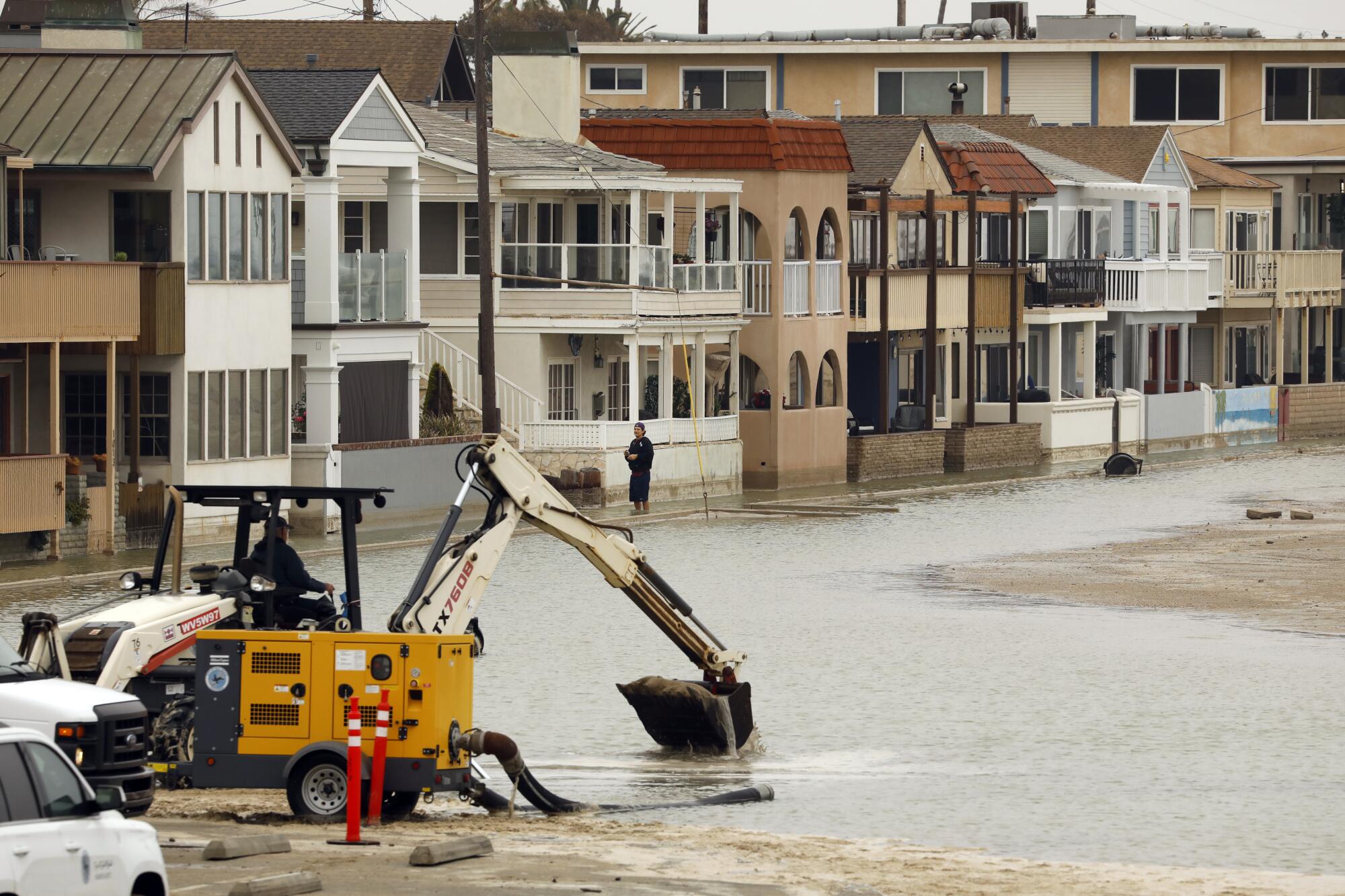
2. Heat waves, wildfires and other extreme events are hitting California and the Southwest hard
The report details how the changing climate is disrupting life, the economy and ecosystems in California and the Southwest.
“We’re seeing increases in extremes, both through drought but also through flooding,” said Dave White, lead author of the report’s Southwest chapter and director of Arizona State University’s Global Institute of Sustainability and Innovation.
Higher temperatures have intensified drought, shrunk the region’s vital mountain snowpack, altered the timing of snowmelt, and reduced river flows. As temperatures continue to climb, scientists project that snowlines will continue to retreat higher in the mountains and low-snow years will happen more often.
Higher temperatures are also unleashing more intense storms and are projected to cause more severe atmospheric river storms.
The Camp fire in Paradise revealed vulnerabilities in forest management, electrical equipment, city planning and evacuations. Has the state made strides against those shortcomings?
Scientists note in the report that the Southwest has, since 2000, experienced a megadrought that research showed to be the driest in 1,200 years, and that rising temperatures have been a major driver. Researchers have estimated that the Colorado River’s average flow is decreasing about 9% with every 1.8 degrees of warming.
Extreme heat, drought and water scarcity are projected to have severe and worsening effects on agriculture in California, reducing crop yields, harming orchards, increasing heat stress for livestock, and shifting zones where crops can be grown — all of which will carry major economic costs.
Already, the report notes, the drought in 2021 cost California agriculture nearly $1.3 billion in estimated losses and more than 8,700 lost jobs.
Unprecedented wildfires have raged in California in recent years, driven in part by the changing climate. Of the nation’s 50 largest wildfires in 2020, 22 of those fires burned in California. And the seven largest wildfires recorded in the state have occurred since 2018. The scientists said high-severity wildfires are expected to continue as temperatures rise, putting people and ecosystems at greater risk.
Along the California coast, the ocean is projected to rise up to 1.25 feet by 2050, and between 3 feet and 6.6 feet by 2100. That will threaten many homes, since the state has more people living near sea level (within roughly three feet) than any other state except Louisiana.
As high-tide flooding worsens for communities, scientists say the rising water may also threaten water infrastructure in the Sacramento–San Joaquin Bay Delta, where California draws a large portion of its water supplies.
While climate-related disasters have increasingly hit California, extreme heat has taken an increasing toll on health. According to the report, there were 7,687 reported hospitalizations in the Southwest due to heat and heat-related illnesses between 2016 and 2020, up from 5,517 cases in the previous five years.
“Climate change is compromising human health and reshaping the demographics of the region,” White said, adding that developing adaptations to extreme heat “is going to be critical priority over the next several years.”
As climate change pushes temperatures to increasing extremes, farmworkers in the Coachella Valley are being exposed to dangerous heat at work and at home.
Those who are most vulnerable include low-income and older people, and those who work outdoors.
Hayhoe said she hopes the assessment drives home that climate change is affecting us “no matter who we are and no matter where we live.”
“Our future is literally in our hands,” she said.
3. U.S. emissions have decreased, while the economy and population have grown
Though global greenhouse gas emissions continue to rise, annual emissions in the U.S. fell 12% between 2005 and 2019, according to the report. Those gains were largely driven by a 40% drop in emissions from the electricity sector, which has made notable strides away from coal power and toward the use of natural gas and renewable technologies. The transportation sector, not electricity, is now the largest emitter in the country.
“California is a wonderful example of the growth in renewable energy and renewable energy capacity,” White said. “We’re seeing rapidly falling costs for low carbon energy technologies.”
In fact, innovations in the energy field are improving the price of zero- and low-carbon energy technology and helping to increase wind, solar and battery storage. The average cost of an electric vehicle battery, for example, has declined from about $1,000 per kilowatt-hour in 2010 to less than $200 today.
Declining U.S. emissions have also occurred against the backdrop of population growth and economic growth, the report says.
But while U.S. emissions have improved in recent years, carbon dioxide can linger in the atmosphere for thousands of years — meaning CO2 emitted long ago continues to contribute to current climate trends. For that same reason, cumulative fossil fuel emissions in the U.S. remain higher than any other country, with U.S. emissions between 1850 and 2021 making up approximately 17% of current global warming, the report found.
The report warns that climate change can contribute to political and social instability, with potential ramifications on defense, diplomacy and national security, and that the crisis is also increasingly affecting global and regional economies, with potential implications for U.S. economic and trade interests.
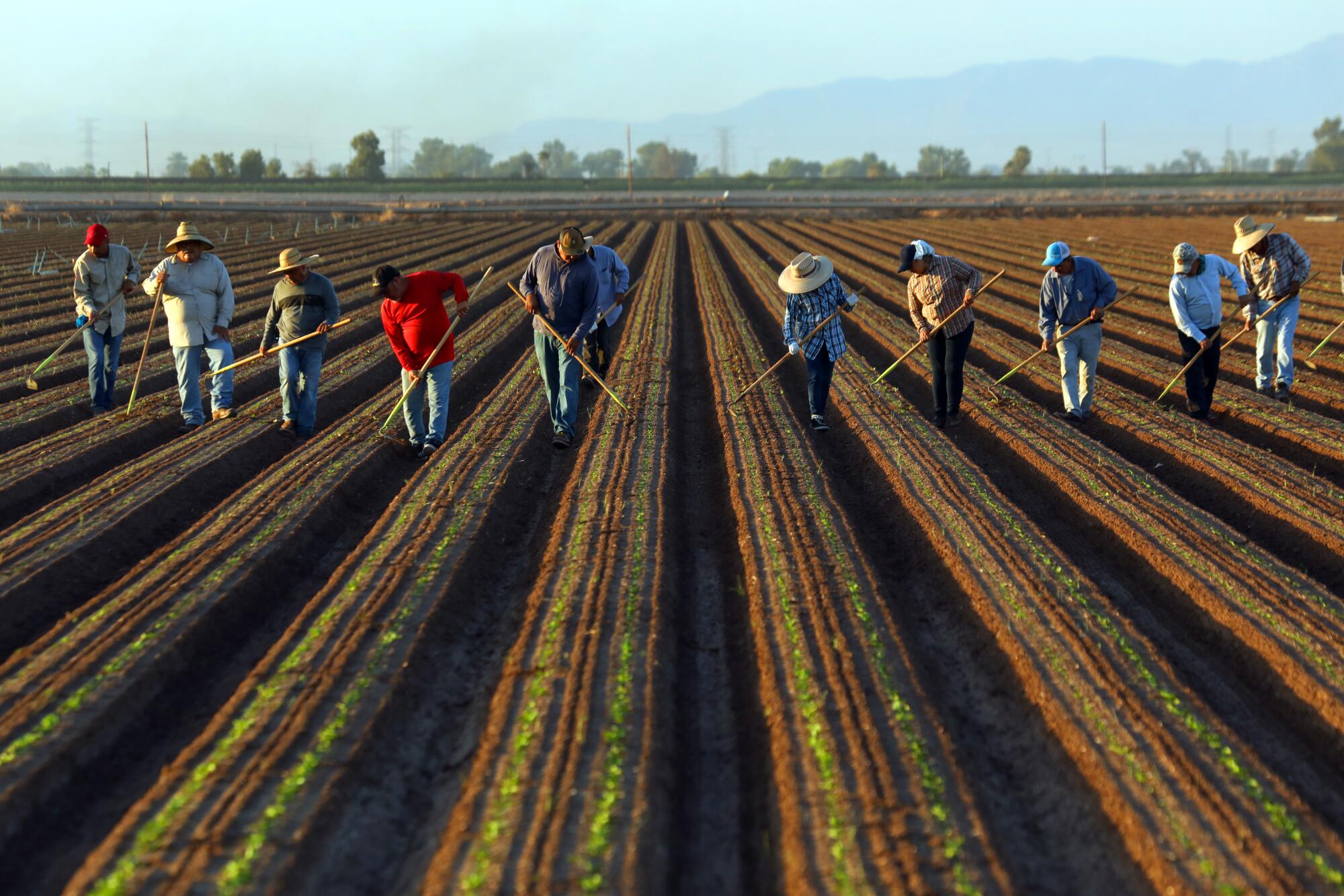
4. Climate change exacerbates inequities
Climate change has exposed many of the inequities and injustices that have long been present in the U.S. That includes systemic discrimination and disinvestment in low-income communities and communities of color that are already burdened by disparities, the report says.
Such effects include a lack of green space, which can worsen heat and air quality, and a lack of adequate flood infrastructure. Both scenarios are familiar in California, where the migrant community of Pajaro saw catastrophic flooding amid winter storms earlier this year. In Los Angeles, low-income communities are consistently hotter than their wealthier counterparts.
In California’s Central Valley, the report noted that droughts have disrupted work for farm laborers, who are also suffering worsening health risks because of extreme heat.
“That is very clear in this report — how the impacts exacerbate many of our social inequalities, and how climate solutions must and can be solutions for justice inequities,” Hayhoe said.
Other health effects include a wider distribution of infectious and vector-borne illnesses such as Zika, Lyme disease and Valley fever, worsening air quality from smog, smoke and dust, and threats to food and water supplies. Mental and spiritual health stressors are also expected, including anxiety, depression and loss of social support systems.
“While climate change can harm everyone’s health, its impacts exacerbate long-standing disparities that result in inequitable health outcomes for historically marginalized people,” the report says.
Dangerous floods, severe drought, extreme heat and polluted air have permanently altered life in California’s San Joaquin Valley. Can it adapt?
5. Climate action has increased in every region of the U.S.
The news isn’t all bad. Across America, efforts to take action against climate change and reduce greenhouse gas emissions have improved since the previous report in 2018.
The researchers found a 32% increase in city- and state-level adaptation plans, as well as expanded renewable energy and energy efficiency projects on tribal lands.
Scientists wrote that effective adaptation in California and the Southwest, where the population has rapidly grown to more than 60 million, will require “flexible decision-making” as well as technological innovations.
California has taken far more adaptation actions than any other state, and is among the leading states for mitigation actions, the report found. Among other efforts, the state is leading the nation in the charge toward electric vehicles, vowing to ban the sale of new gas-powered cars by 2035.
“I feel good, as a Californian, about the way California has backed mitigation efforts,” said Steven Davis, a professor of Earth System Science at UC Irvine, lead author of the report’s mitigation chapter. “I think we’re definitely at the fore — and probably pulling a lot of other states along with us.”
One-fifth of all conifer forests in the Sierra are mismatched with the warmer climate and may not survive, according to Stanford University researchers.
However, adaptation efforts aren’t keeping up with the pace of climate change, the report found. Relying on air conditioning to fight heat waves, reducing water consumption to address droughts, or using sandbags to resist coastal erosion are temporary solutions, as opposed to transformative ones.
What is necessary, the report says, are “in-depth changes that shift the fundamental traits of institutions, behaviors, values or technologies.”
The findings emphasize that just as each additional increment of warming can create more damage, each increment of warming prevented reduces the harmful effects and the risks.
“The National Climate Assessment provides us both the topography of the risk as it cascades through our economy — touching every sector, every segment of the economy — as well as the atlas of opportunity,” White House National Climate Advisor Ali Zaidi told reporters.
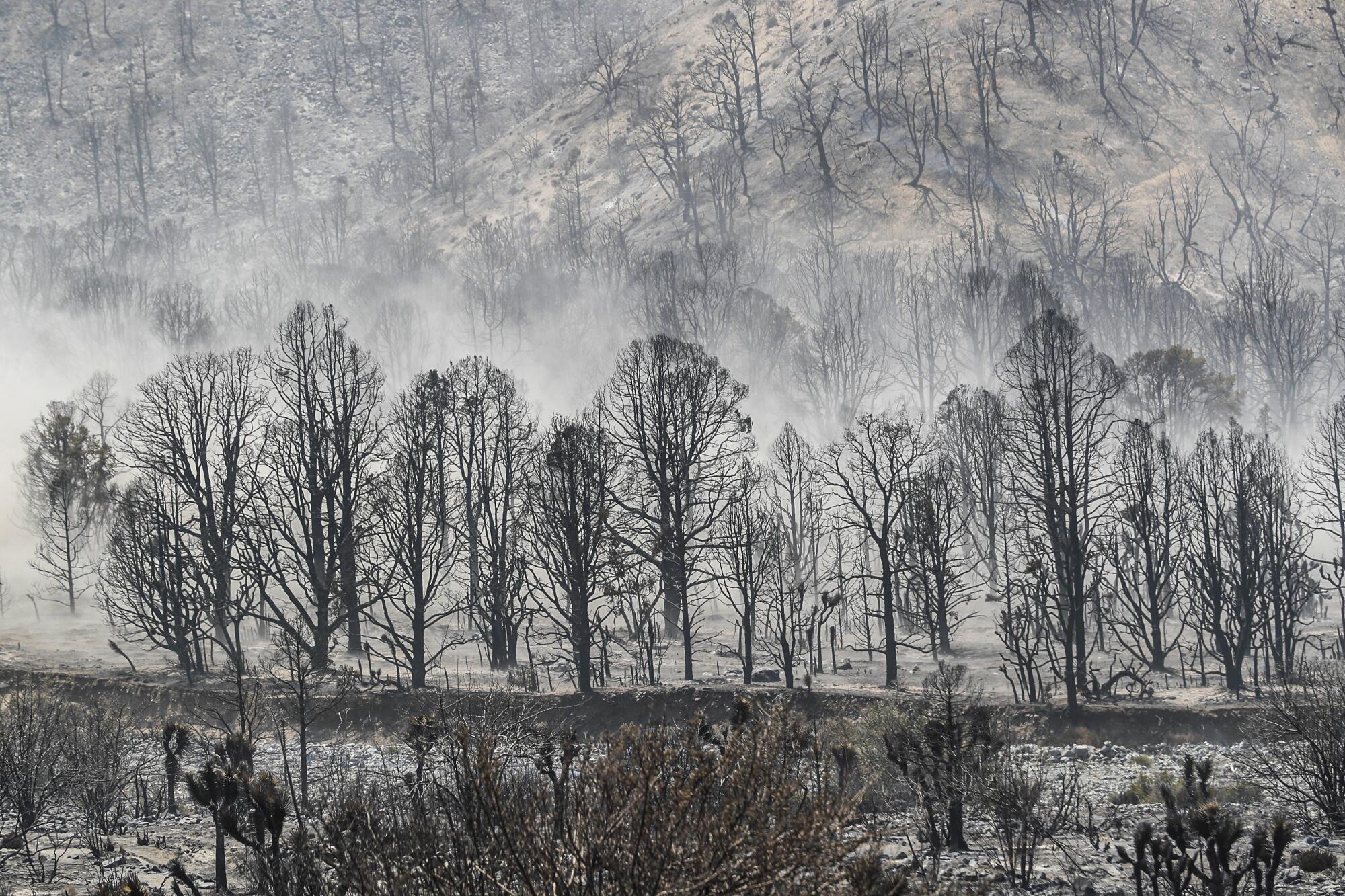
6. Meeting U.S. mitigation targets means reaching net-zero emissions
Scientists say improving the outlook for people and the planet will require, first and foremost, curbing emissions from fossil fuels and other sources to mitigate the worst effects of climate change.
Meeting U.S. mitigation targets would unequivocally require reaching net-zero emissions, the report says. That means either reducing carbon emissions to zero or balancing residual emissions by removing them from the atmosphere.
“We actually have technologies in hand that can cost-effectively drastically reduce our greenhouse gas emissions,” Davis said. They include renewable energy sources such as wind and solar, electric vehicles and electric heating of buildings. “All of those technologies — which have only gotten supercharged with [President Biden’s] Inflation Reduction Act — are ready to go, and can make big dents in the country’s greenhouse gas emissions.”
When it comes to removing carbon from the atmosphere, nature-based solutions such as increasing forest cover can help, since trees absorb CO2, as can newer advancements and industrial solutions, such as a new facility in Tracy, Calif., that pulls pollution from the air.
Solar and wind developers says far more is needed to stem the climate crisis.
California has set a goal of being carbon neutral by 2045 and has released a blueprint for moving toward that objective. The report notes that Colorado and New Mexico have state goals for reducing greenhouse gases, and that dozens of cities in the Southwest have committed to emissions reductions.
But there is still work to do. While national and international agreements seek to limit global warming to 2.7 degrees, or 1.5 degrees Celsius, above preindustrial levels, the planet is already coming perilously close to that threshold, with 2023 expected to be Earth’s hottest year on record.
U.S. greenhouse gas emissions are not falling fast enough to meet national and international goals, and to get there would require declines of more than 6% per year on average. By comparison, U.S. greenhouse gas emissions decreased by less than 1% per year on average between 2005 and 2019.
Davis acknowledged that it’s hard to see a path for the planet to meet that 2.7 degree goal, but said there are great indicators of progress on clean energy, and other key efforts.
“I feel optimistic about us being able to drastically cut our emissions and perhaps meet those pledges that we’ve made as a country,” he said.
He also lauded Biden’s Inflation Reduction Act as a landmark climate bill. “It’s a big deal,” he said, “and that, plus the fact that these technologies are now cheap enough that they can compete with the incumbent fossil technologies, is a real source of hope for all of us.”

